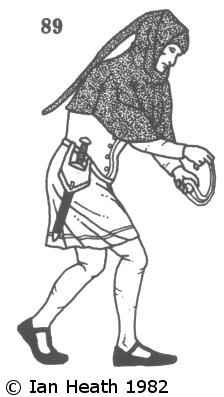CASTILIAN SLINGER
An extract from Armies of the Middle Ages, volume 1
by Ian Heath

89. CASTILIAN SLINGER
Edward I of England is recorded employing an elite unit of slingers in 1303, and the weapon remained in use in some parts of Europe at least until the end of the 14th century, notably in Spain where Froissart records slings being used at Nájera and Valverde.
In 1386 he records that Juan I had 'of infantry casting stones with slings' more than 30,000.
Of the Battle of Nájera he wrote: 'The Spanish commonalty made use of slings, to which they were accustomed, and from which they threw large stones'.
Of the weapon's effectiveness, he adds that they 'threw stones with such force they could split a helmet in half',
specifically stating that 'the English at first suffered severely from the Spanish slingers' before the heavy fire of the English longbows disorganised and routed them.
It seems more than probable that at least some of these slingers were armed with staff-slings (it is barely conceivable that an ordinary hand-slung missile could 'split a helmet in half').
Staff-slings are mentioned and illustrated in a fair number of 14th-15th century sources in both battles and sieges, even being used by fully-armoured men.
Among their missiles were bars of iron, lead balls, stones and fire grenades.
This figure wears typical lower-class European dress of c.1360.
In particular note the hood; the long tubular point at the back was called in England a liripipe and could be wrapped round the neck and chin like a scarf for warmth.
Other than his sling he is armed only with a knife.
It is possible that he may also have carried a buckler; certainly an
illustrated edition of Froissart of something over a century later depicts a Spanish slinger at Nájera using a shield in his left hand in conjunction with the sling.
|
|

